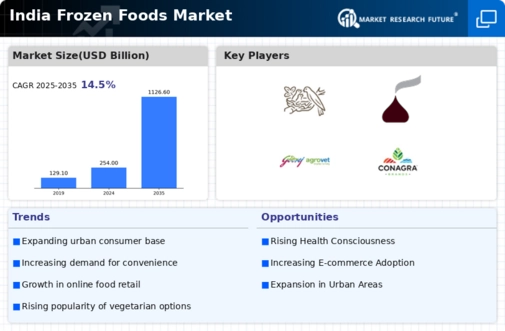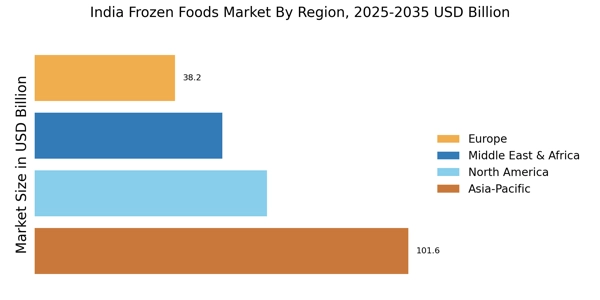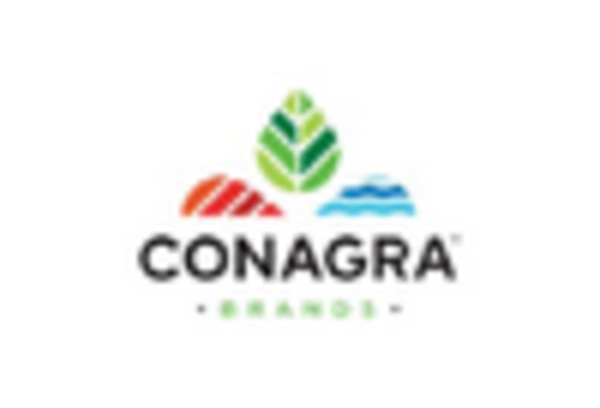Adoption of Innovative Packaging Solutions
The India Frozen Foods Market is benefiting from the adoption of innovative packaging solutions that enhance product appeal and convenience. Packaging plays a crucial role in preserving the quality and freshness of frozen foods, and advancements in technology have led to the development of materials that improve shelf life and reduce waste. For instance, vacuum-sealed packaging and modified atmosphere packaging are becoming increasingly popular, as they help maintain the integrity of the food. This trend is likely to attract more consumers to frozen food products, as they seek options that are not only convenient but also retain their nutritional value. The emphasis on sustainable packaging solutions may further influence purchasing decisions, as environmentally conscious consumers look for brands that align with their values. Thus, the India Frozen Foods Market is expected to see growth driven by these packaging innovations.
Increased Focus on Food Safety and Quality
The India Frozen Foods Market is witnessing a heightened emphasis on food safety and quality standards. Consumers are becoming increasingly aware of the importance of safe food handling and preservation methods. This trend is reflected in the growing demand for frozen foods, which are often perceived as safer due to their extended shelf life and reduced risk of spoilage. The Food Safety and Standards Authority of India (FSSAI) has implemented stringent regulations to ensure that frozen food products meet safety standards, thereby boosting consumer confidence. As a result, the market for frozen foods is likely to expand, with consumers opting for products that adhere to these safety protocols. This focus on quality and safety is expected to drive growth in the India Frozen Foods Market, as brands that prioritize these aspects may gain a competitive edge.
Rising Urbanization and Changing Lifestyles
The India Frozen Foods Market is experiencing a notable transformation due to rising urbanization and evolving lifestyles. As more individuals migrate to urban areas, the demand for convenient food options increases. Urban consumers often lead busy lives, which drives the preference for ready-to-eat and frozen food products. According to recent estimates, urban areas in India are projected to account for over 50% of the population by 2030, further amplifying the need for quick meal solutions. This shift in consumer behavior indicates a growing market for frozen foods, as they offer convenience without compromising on taste or quality. The India Frozen Foods Market is thus poised to benefit from this demographic change, as manufacturers adapt their offerings to meet the needs of urban dwellers.
Expansion of Retail and Distribution Channels
The India Frozen Foods Market is experiencing growth due to the expansion of retail and distribution channels. Traditional grocery stores, supermarkets, and hypermarkets are increasingly dedicating shelf space to frozen food products, making them more accessible to consumers. Additionally, the rise of e-commerce platforms has revolutionized the way frozen foods are marketed and sold. Online grocery shopping is becoming more prevalent, allowing consumers to conveniently order frozen products from the comfort of their homes. According to industry reports, the online grocery market in India is expected to grow significantly, further enhancing the reach of frozen food brands. This expansion of retail and distribution channels is likely to drive sales in the India Frozen Foods Market, as consumers benefit from greater availability and variety of frozen food options.
Growing Influence of Social Media and Food Trends
The India Frozen Foods Market is increasingly influenced by social media and emerging food trends. Platforms such as Instagram and Facebook have become vital in shaping consumer preferences, as visually appealing food content drives interest in frozen food products. Influencers and food bloggers often showcase innovative recipes using frozen ingredients, which can enhance the perceived value of these products. Additionally, trends such as plant-based diets and ethnic cuisines are gaining traction, leading to a diversification of frozen food offerings. As consumers become more adventurous in their culinary choices, the demand for unique and diverse frozen food options is likely to rise. This social media-driven trend may significantly impact the India Frozen Foods Market, as brands that effectively leverage these platforms can reach a broader audience and stimulate sales.


















Leave a Comment